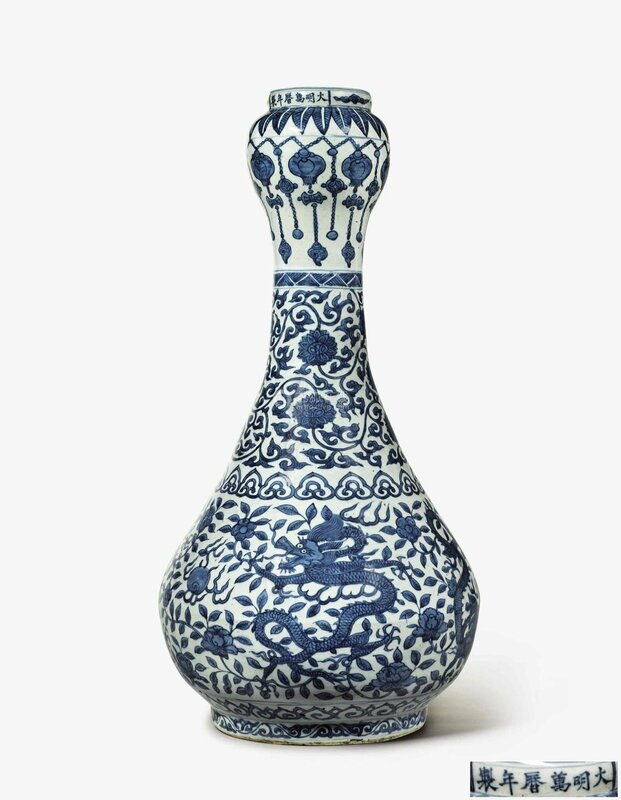A large and finely painted blue and white 'dragon' garlic-mouth bottle vase, Wanli mark and period (1573-1619)
Lot 11. A large and finely painted blue and white 'dragon' garlic-mouth bottle vase, Wanli mark and period (1573-1619). Estimate 300,000 — 500,000 USD. Lot sold 612,500 USD. Photo Sotheby's.
sturdily potted, the pear-shaped body supported on a short foot, tapering to a tall neck with a garlic-head mouth and upright mouth rim, the body painted with two pairs of of sinuous five-clawed dragons, alternately descending and ascending in pursuit of 'flaming pearls' amidst a composite floral scroll, all above floral scroll and lappets at the foot, and below a border of ruyi at the shoulder, the waisted neck painted with lotus scrolls beneath strings of beads suspending jewels and precious objects, below a pendent stiff leaf band, the six-character reign mark inscribed in a horizontal line within a rectangular cartouche at the rim, wood stand, Japanese wood box. Quantité: 4
Note: Garlic-mouth vases of this distinctive form are outstanding among the larger Wanli wares and examples are known decorated with several variations in the horizontal bands. A very similar vase in the Shanghai Museum is illustrated in Lu Minghua, Mingdai guanyao ciqi [Ming imperial porcelain], Shanghai, 2007, pl. 1-74; another was sold at Christie’s New York, 28th March 1996, lot 343, and published in Regina Krahl, Chinese Ceramics from the Meiyintang Collection, London, vol. 4, pt. 1, 2010, pl. 1697; and a third, but with a reduced rim, from the collection of Dr Hsi Hai Chang, Minister Plenipotentiary of the Chinese Republic, was sold in these rooms, 23rd/24th May 1974, lot 352. Two related vases, with the same design but with a lingzhi scroll on the neck, were sold in our London rooms, the first, from the Hay collection, on 25th June 1946, lot 24, and the second on 21st June 1983, lot 249; and another was sold at Christie’s London, 27th November 1967, lot 42.
Similar vases can also be found painted in the wucai palette; see one illustrated in John Ayers, The Baur Collection. Geneva, vol. 2, Geneva, 1969, pl. A203; and one in the National Palace Museum, Taipei, published in Minji meihin zuroku, vol. III, Tokyo, 1978, pl. 99. See also a smaller vase, formerly in the Lindley-Scott Collection and later sold in our London rooms, 4th July 1945, lot 80, included in Soame Jenyns, Ming Pottery and Porcelain, London, 1988, pl. 187; another in the Chang Foundation published in James Spencer, Selected Chinese Ceramics from Han to Qing Dynasties, Taipei, 1990, pl. 110; and a third sold in our Los Angeles rooms, 2nd November 1981, lot 304.
The shape of this vase, with its bulbous head, appears to be based on archaic bronze prototypes, such as a pair attributed to the Western Han period (206 BC – AD 9), sold twice in our New York rooms, 12th/13th March 1975, lot 157, and again, 22ndMarch 2011, lot 191, from the collection of J.T. Tai & Co. Chenghua blue and white porcelain would also have served as inspiration; for an example of which see a pear-shaped vase rising to a lotus bud-shaped mouth with raised overlapping layers of petals, the body painted with lotus blooms on meandering leafy stems, sold in these rooms, 9th October 2007, lot 1557.
Vases of this form are found decorated in a variety of designs in both underglaze blue and polychrome enamels; for example see one painted with dragons and phoenixes in cobalt, from the B.S.N. Niigata Hoso Museum, sold at Christie’s Hong Kong, 1st June 2011, lot 3591; and a wucai example, in the National Palace Museum, Taipei, illustrated in Enamelled Ware of the Ming Dynasty, bk. III, Hong Kong, 1966, p. 31, pl. 1; another decorated in underglaze blue with an aquatic scene, from the Charles B. Hoyt collection, in the Museum of Fine Arts, Boston, acc. no. 49.24; and a colorfully enameled example, but of smaller size, in the Schlossmuseum, Berlin, illustrated in Robert Schmidt, Chinesische Keramik von der Han-Zeit bis zum XIX. Jahrhundert, Frankfurt am Main, 1924, pl. 69.
Another commonly found motif on Wanli vases of this form is that of birds and waterfowl; see a pair of vases from the Idemitsu Museum of Arts, Tokyo, included in the exhibition Imperial Overglaze-Enamelled Wares in the Late Ming Dynasty, Museum of Oriental Ceramics, Osaka, 1995, cat. no. 22; two larger vases in the National Palace Museum, Taipei, one illustrated in Minji meihin zuroku, vol. III, Tokyo, 1978, pl. 100, and the other published in Liu Liang-yu, Ming Official Wares,Taipei, 1991, p. 255 (top right); and another in the Palace Museum, Beijing, published in Zhongguo taoci quanji, vol. 13, Shanghai, 2000, pl. 109, possibly of the same size as the present vase but with the rim damaged. A related vase was included in the International Exhibition of Chinese Art, the Royal Academy of Arts, London, 1935, cat. no. 1912, and later sold in our London rooms, 24th March 1953, lot 62; another was sold at Christie's Hong Kong, 5th/6th November 1997, lot 1050; another was sold in these rooms, 8th April 2007, lot 525; and a fourth vase, sold in these rooms, 23rd October 2005, lot 456, is illustrated in Julian Thompson, The Alan Chuang Collection of Chinese Porcelain, Hong Kong, 2009, pl. 26.
Sotheby's. Ming: The Intervention of Imperial Taste, New York, 14 mars 2017, 10:00 AM

/https%3A%2F%2Fprofilepics.canalblog.com%2Fprofilepics%2F1%2F0%2F100183.jpg)
/https%3A%2F%2Fstorage.canalblog.com%2F03%2F02%2F119589%2F96711876_o.jpg)
/https%3A%2F%2Fstorage.canalblog.com%2F11%2F31%2F119589%2F94773502_o.jpg)
/https%3A%2F%2Fstorage.canalblog.com%2F20%2F83%2F119589%2F94772815_o.jpg)
/https%3A%2F%2Fstorage.canalblog.com%2F26%2F72%2F119589%2F75604929_o.jpg)
/https%3A%2F%2Fstorage.canalblog.com%2F59%2F60%2F119589%2F26458628_o.jpg)






/image%2F1371349%2F20240416%2Fob_2a8420_437713933-1652609748842371-16764302136.jpg)
/image%2F1371349%2F20240414%2Fob_83ee65_2024-nyr-22642-0954-000-a-blue-and-whi.jpg)
/image%2F1371349%2F20240414%2Fob_15808c_2024-nyr-22642-0953-000-a-blue-and-whi.jpg)
/image%2F1371349%2F20240414%2Fob_e54295_2024-nyr-22642-0952-000-a-rare-blue-an.jpg)